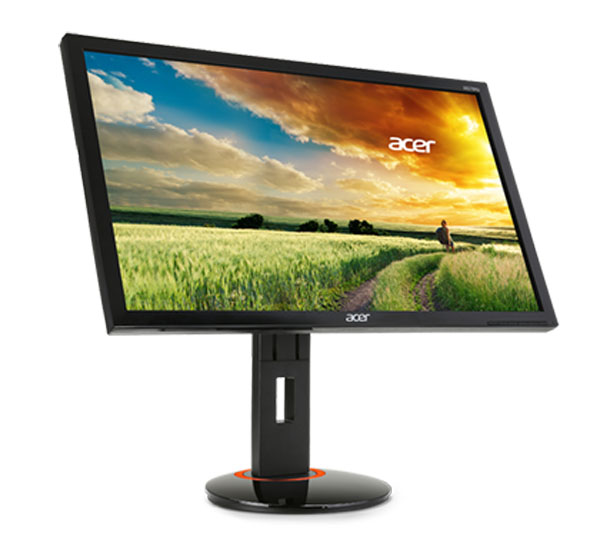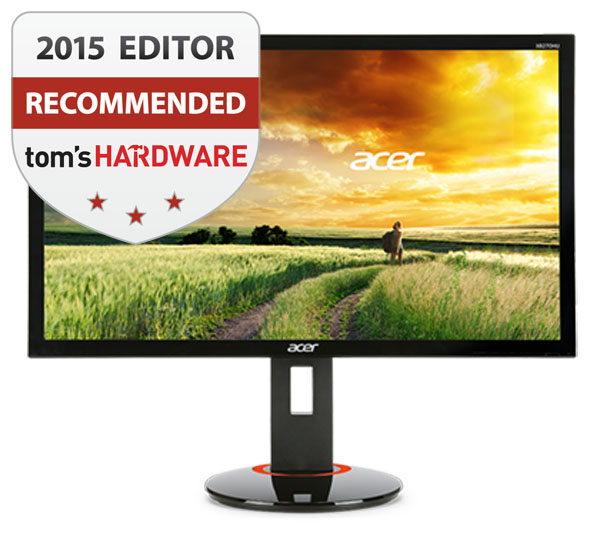Acer XB280HK 28-inch G-Sync Ultra HD Gaming Monitor Review
Acer breaks new ground with its XB280HK. Offering an Ultra HD resolution and G-Sync in a reasonably-priced 28-inch package, this monitor is unique.
Why you can trust Tom's Hardware
Conclusion
In our Ultra HD monitor reviews so far, we’ve seen mostly professional screens (with prices to match) rather than products created specifically for gaming. This isn’t surprising, since many UHD displays are still more expensive than most of us are willing to pay. Aside from a little relief in the 28-inch category, a 3840x2160 pixel display can still cost as much or more than the rest of your rig.
Acer did something very smart in designing its XB280HK. By optimizing a value-priced TN panel for performance and adding G-Sync, it created a product truly worthy of a high-end gaming system. You won’t get an extras like motion blur-reduction, 144Hz refresh rates or special picture modes. What you do get for around 800 dollars is the best possible Ultra HD gaming experience available right now.
While the price is high, bear in mind that you need to spend some serious coin on a decent video card (or cards) to push more than eight megapixels above 30 frames per second. That’s the lower limit of G-Sync technology, regardless of which monitor you buy. Granted, the frame-doubling technique used by Nvidia prevents increased input lag when frame rates drop below 30. But realistically, the experience is greatly diminished by this point, so skimping on graphics power just doesn’t make sense when Ultra HD is the goal.
If you’re concerned about the XB280HK’s 60Hz ceiling, you needn’t be. When G-Sync is active, the elimination of tearing and stuttering artifacts imparts a smoothness to motion that makes you think the refresh rate is much higher. In fact, at this point in time, the choice between G-Sync, FreeSync or 144Hz comes down to whether or not you want to lock yourself into one brand of video board.
At 144Hz, most artifacts, including tears, are pretty minimal as long as you can keep the frame rate high. But using G-Sync means the high refresh rate isn’t really necessary. So we don’t believe the 60Hz limit is a big deal. My experience in actual game play was overwhelmingly positive. With a powerful system behind it, this monitor excels.
In the more traditional metrics, we’re pleased with the XB280HK’s color and grayscale accuracy. Our only wish is for better contrast. Though it competes favorably with other 28-inch UHD/TN screens, it lags a little behind competing 24- and 27-inch gaming monitors we’ve tested.
We continue to maintain that more choices mean lower prices and better quality. Acer is the first company to put Ultra HD and G-Sync in the same chassis. It certainly won’t be the last, though. As GPU speeds continue to increase, we’ll probably see more and more high-res screens made for gaming.
Get Tom's Hardware's best news and in-depth reviews, straight to your inbox.
The XB280HK isn’t perfect. But it is a competent display that will undoubtedly attract many enthusiasts. For its unique combination of Ultra HD and G-Sync, plus solid performance and build, we’re giving it the Tom’s Hardware Editor Approved award.
MORE: Best Computer MonitorsMORE: Display Calibration 101: Step-By-Step With Datacolor's Sypder4Elite
MORE: Do It Like Tom's: Calibrating Your Monitor With Calman RGB
MORE: Display Calibration 201: The Science Behind Tuning Your Monitor
MORE: All Monitor Articles
MORE: Latest Monitor News
Christian Eberle is a Contributing Editor for Tom's Hardware, covering Monitors and TVs.
Follow Tom's Hardware on Twitter, Facebook and Google+.

Christian Eberle is a Contributing Editor for Tom's Hardware US. He's a veteran reviewer of A/V equipment, specializing in monitors. Christian began his obsession with tech when he built his first PC in 1991, a 286 running DOS 3.0 at a blazing 12MHz. In 2006, he undertook training from the Imaging Science Foundation in video calibration and testing and thus started a passion for precise imaging that persists to this day. He is also a professional musician with a degree from the New England Conservatory as a classical bassoonist which he used to good effect as a performer with the West Point Army Band from 1987 to 2013. He enjoys watching movies and listening to high-end audio in his custom-built home theater and can be seen riding trails near his home on a race-ready ICE VTX recumbent trike. Christian enjoys the endless summer in Florida where he lives with his wife and Chihuahua and plays with orchestras around the state.
-
Frozen Fractal On first glance I thought I wouldn't have to see "we will be reviewing XB270HU soon" quote again. But then I realized it's XB280HK. Oh well, guess have to endure that quote for few more time :rolleyes:Reply
Contrast ratio, brightness, chromacity & gamma tracing is where XB280HK looses the ground, but to be fair, most of the gamers won't be noticing much difference at all. But it is kind of disappointing to see Planar do better in these fields than Acer utilizing the same panel. I don't know, maybe the overdrive somehow worsen the results?
But ofcourse, it does well on uniformity and response time. Makes me wonder why XB280HK doesn't have ULMB if it's supposed to be a bundled feature with G-Sync. That should've helped in 60Hz panels more, rather than 144Hz ones.
But anyway, XB280HK looks promising, although I don't think 4K is what I prefer for gaming+life (although I do for gaming only). -
Frozen Fractal Reply16328127 said:Sorry if i missed it but what version display port is it?
It's 1.2a I presume. Since that's what is capable of 4K@60Hz other than HDMI 2.0 -
boju Should be at least version 1.2 for 4k @ 60Hz since this version has been doing this since year 2009. v1.2a is the same Res/Hz deal but brings added support for Freesync.Reply
-
picture_perfect Why do they keep pushing 4K for gaming. True gamers have always regarded fps as king and 4K is one-quarter the frame rate of 1080. Gamers don't need expensive 4K monitors driven by expensive cards at ever-lower frame rates (via G-sync). This is chasing the proverbial tail and counterproductive. Regular 1080p, v-synced at a constant 144 fps would be better than all that stuff.Reply -
spagalicious ReplyWhy do they keep pushing 4K for gaming. True gamers have always regarded fps as king and 4K is one-quarter the frame rate of 1080. Gamers don't need expensive 4K monitors driven by expensive cards at ever-lower frame rates (via G-sync). This is chasing the proverbial tail and counterproductive. Regular 1080p, v-synced at a constant 144 fps would be better than all that stuff.
*Competitive Gamers
People that like to play games also like to play games in ultra HD resolutions.
-
picture_perfect 4K is cool but GPUs cant handle it well enough yet. I'd rather have 1080p at high fps and gain an extra 1-2 frames of lag, but to each their own.Reply -
bystander Reply16328109 said:But ofcourse, it does well on uniformity and response time. Makes me wonder why XB280HK doesn't have ULMB if it's supposed to be a bundled feature with G-Sync. That should've helped in 60Hz panels more, rather than 144Hz ones.
ULMB uses flickering to lower persistence, which reduces the motion blur. If you've ever used 60hz CRT monitors, you'll know that flickering is painful on the eyes. This is why ULMB mode is not offered on 60hz monitors, and likely won't be offered on anything less than 75-85hz.
-
bystander Reply16329841 said:4K is cool but GPUs cant handle it well enough yet. I'd rather have 1080p at high fps and gain an extra 1-2 frames of lag, but to each their own.
Top end GPU's can handle 4K just fine. You just don't play it at max settings. What is better, medium to high settings and 4K, or maxed at 1080p? That is a subjective question, and will vary from person to person.
That said, I prefer higher refresh rates than 60hz, so I'll be going 1440p before 4K.

